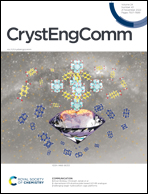Luminescence properties of Eu2O3-doped ZrO2–Y2O3 single crystals†
Abstract
The synthesis, structure, and optical properties are reported for a series of yttria-stabilized zirconia crystals in which some Y3+ was replaced by Eu3+. These crystals were grown by the optical floating zone (OFZ) method and were transparent without inclusions, cracks, or bubbles. They were all exclusively in the cubic phase, whereas the corresponding ceramic samples had a mixture of monoclinic and cubic phases. Absorption spectra showed a charge transfer band at 268 nm and a series of narrow peaks in the range 308–540 nm from Eu3+ f–f transitions. The crystals were efficiently excited at 393 nm, and exhibited excellent orange-red photoluminescence (PL) centred at 610 nm, from the 5D0 → 7F1 transition. The maximum PL intensity was observed with crystals prepared with 2.00 mol% Eu2O3, and compared with other rare earth ions; Eu3+-doped ZrO2–Y2O3 single crystals have a high concentration quenching threshold. The critical distance for Eu3+ ions was calculated as 11.8 Å, which indicates that multipole–multipole interactions dominate the non-radiative energy transfer between Eu3+ ions. Finally, the chromaticity coordinates (CIE) for all the samples were similar, and those for the (ZrO2)92(Y2O3)6(Eu2O3)2 crystal were (x = 0.6339, y = 0.3657) with a colour purity >98%.



 Please wait while we load your content...
Please wait while we load your content...